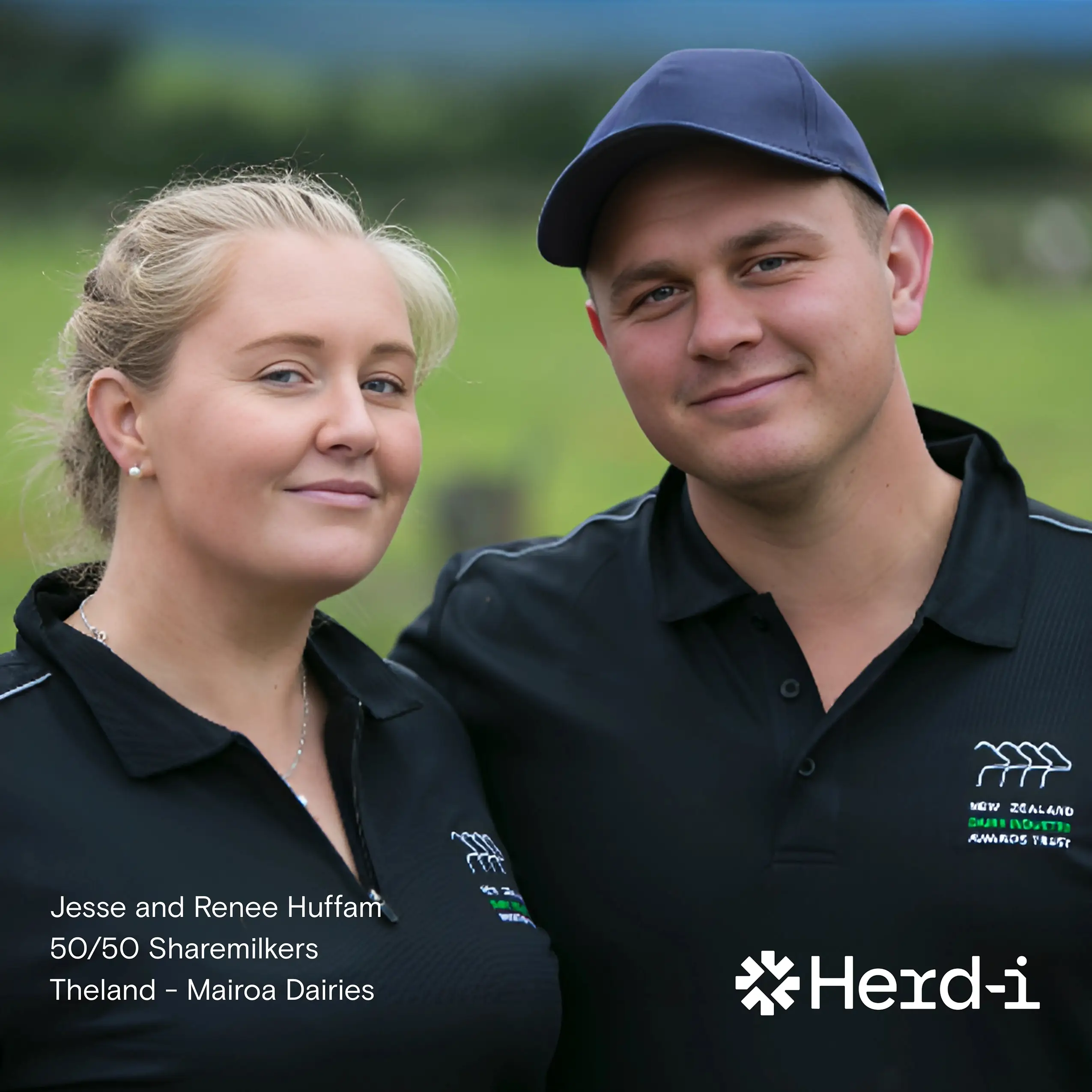At Herd‑i, we know that every farmer finds their own reasons to welcome Ai onto their farm. That’s why we’ve started a series where we sit down with farmers in the shed to find out why they’ve made the decision to join the Herd‑i herd. Each farm has its own challenges, every farmer has their own goals and we’ll be back in a year to see what has changed.
This time we’re with Jesse and Renee Huffam, 50/50 sharemilkers with Theland in Taupo at Mairoa Dairies. Together they milk around 1,900 cows, with young stock and support blocks stretching their total operation to more than 1,970 hectares. They’ve built a reputation as smart, progressive operators who put people and planning at the centre of everything they do.
Our conversation with Jesse and Renee began at National Fieldays 2025. “We just saw that big screen showing cows being scored, and next thing Liz Muller (CEO) was explaining to me how it works,” Jesse recalls. “We weren’t shopping for tech – but what Herd‑i was showing made sense straight away.”
That conversation was about more than a new technology on farm. At Fieldays, Herd‑i was challenging farmers to Rethink the way they manage Body Condition Scoring and Lameness in their herds. Ultimately, the question is this: why rely on occasional subjective visual checks when Ai can deliver daily, consistent data using technology that doesn’t get tired or distracted? For Jesse and Renee, who already run a complex, high-performing operation, that challenge hit home. They are a perfect example of why on‑farm Ai makes sense: the scale of their farm, the distances their cows walk, and the pressure on staff means issues might be missed.
Herd-i’s big screen at Fieldays showed exactly what Herd‑i does: Ai-powered cameras in the shed that provide automated lameness scoring and body condition scoring of every cow every day. That data flows back to the farm team so they can make timely data‑driven decisions.
For Jesse, it was like looking at the answer to a problem they’ve been battling with for years. Lameness is a major issue on kiwi dairy farms, and the numbers are sobering. In fact, AgriHealth’s Lameness Management in New Zealand Dairy Cows (2023) reports that on any given day, around 75% of clinically lame cows are still walking to and from the shed in the main herd, undiagnosed and untreated.
“We have a heap of cows – 1,600 – 1,800 in milk – and at any time there might be 150 or 160 lame, that’s at least 10% of the herd that we know about,” says Jesse Huffam. “You just can’t spot them all. I don’t have the staff who are skilled enough to see them early enough – and I’m not paying someone to stand there three times a week trying. By the time you notice them limping, it’s too late. If Herd‑i can flag lame cows earlier so we can draft them before they become clinical, that’s a game changer for us.”
As well as the lameness system, Herd-i’s daily body condition scoring also caught his attention.
“What I need is consistency” says Jesse. “Humans can’t score 1,800 cows every week. But a camera can do it every day, the same way. That means we can draft cows into the correct mobs and know it’s right.”
Renee sees Herd‑i as a way to make their good people even better.
“We’re a factory farm. You can’t be watching that stuff all the time,” says Renee Mason. “Mental fatigue sets in – some of the guys are just flat out putting cups on, not looking at anything else. Tech becomes another set of eyes, and another brain that doesn’t get tired. It does the thinking for them.”
It’s a philosophy they already live by. The couple run Halter across the farm, using technology to enhance good stockmanship. Herd‑i is just the next step, and they’re realistic about what the systems can and can’t do.
“It’s not a silver bullet,” Jesse says. “You still need a plan and to employ good people. But if it saves even 10% of lame cows or gives me the data to help me draft them before things get bad – that’s already a win.”
Asked what success will look like in 12 months, Jesse doesn’t hesitate.
“Confidence. If Herd‑i can identify the cows early that need attention and I can trust it, that’s success. If it works, I’ll be the one at Fieldays telling everyone about it.”
For Jesse and Renee, Herd‑i is a way for them to back their people and give them more time to focus on other things.
This is why we love sharing our customers’ stories – because every farm has a different reason for wanting to change the game on their farm by joining the Herd‑i herd . . . . and in 12 months, we’ll be back catching up with Jesse and Renee to see how it’s gone.

